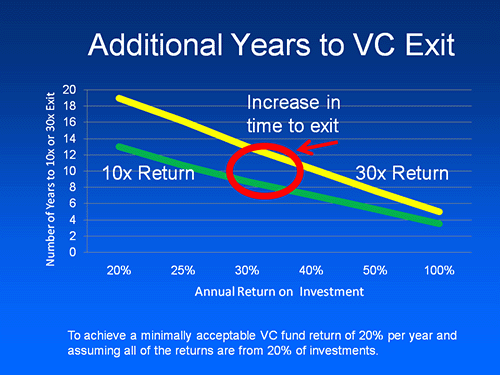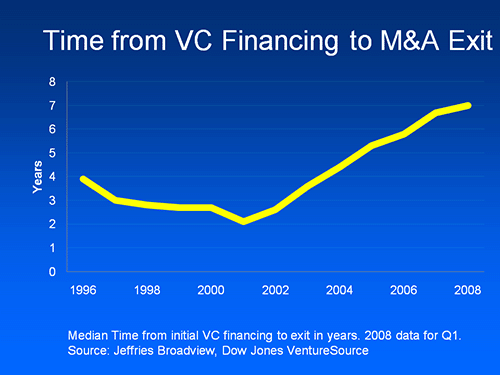In my previous posts — Venture Capital Firms are Too Big and Venture Capital Funds: How the Math Works — I discussed how venture capital investors tend to invest excessively and only aim to exit when the returns are exceptionally high.
But why is that a problem for entrepreneurs and angel investors?
It turns out this behavior can be extremely problematic. These venture capital (VC) tendencies lead to two major issues:
- Venture capital exit times are significantly longer than most people realize.
- The probability of achieving a successful exit drops dramatically over time.
In this post, I’ll explore why VC-backed companies often take so long to exit — and what that means for early-stage investors and founders.
Why VC Exit Times Are So Long
Required Returns: 10x to 30x

To deliver a minimum acceptable return of 20% per year to their limited partners, VCs aim for portfolio companies that can generate 10x to 30x returns.
This has a huge impact on exit timelines. Achieving such large returns takes time — especially when factoring in dilution from future financing rounds and employee equity pools. VCs aren’t just looking for enterprise value growth; they care about per-share value growth, which is a tougher target.
Some companies might manage to increase share value by 30–40% annually, but this is rare and requires both exceptional performance and a bit of luck.
That’s why the time to exit for VCs often stretches to 8–10 years, as shown in the model graph referenced earlier. It may sound excessively long — but is it really?
What the Data Shows

The following chart offers real-world data on actual VC exit times.
- In the late 1990s, the median time from initial VC investment to M&A exit was about three years.
- In 2000, during the tech bubble peak, it dropped to two years due to a surge in deal velocity.
- Since the burst of the bubble, exit times have steadily increased — and now sit at around seven years.
That’s the median — many companies take much longer.
What This Means for Entrepreneurs and Angels
At first glance, it might seem that adding VC funding simply increases the exit timeline by seven years. But the reality is more nuanced.
A Closer Look: A Simple Investment Model
Consider the example below to better understand how exit timelines evolve:
- Year 0: Friends and family invest.
- Year 2: Angel investors come in.
- Year 4: Series A VC funding is raised.
- Year 8: Series B VC round.
- Year 10: Series C VC round.
- Year 16: The company exits.
The breakdown of investor holding periods:
- Series A VCs are in for 12 years.
- Series B VCs for 8 years.
- Series C VCs for 6 years.
A total of $25 million is invested across all VC rounds — aligning with the average deal size discussed in Venture Capital Firms are Too Big.
This model accurately reflects the median VC investment amount and the median investment-to-exit time of seven years.
But What About the Angels and Founders?
Here’s the critical insight: The real exit timeline for early investors and founders is far longer.
- Angels invest in Year 2 and exit in Year 16 — a 14-year hold.
- Founders may wait 16 years to see liquidity.
This is not just theory — while we lack comprehensive data, this model offers a realistic approximation of how venture capital impacts exit timelines.
Final Thoughts
Accepting venture capital can dramatically extend the time it takes for a company to reach an exit — especially for early stakeholders. While it may accelerate growth, it also shifts expectations and imposes longer timelines and higher return thresholds.
My next post will further explore these dynamics and how they tie into themes from my book:
Early Exits: Exit Strategies for Entrepreneurs and Angel Investors — But Maybe Not VCs.
